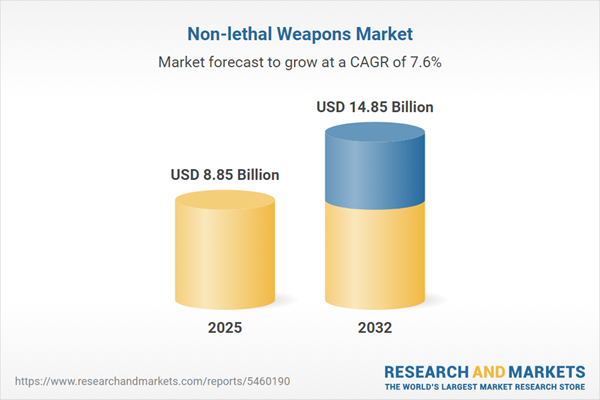Speak directly to the analyst to clarify any post sales queries you may have.
Senior decision-makers are increasingly recognizing the non-lethal weapons market as a critical area for driving secure, compliant, and flexible protection strategies across diverse operating environments. These advanced technologies continue to gain traction as essential components in modern security frameworks.
Market Snapshot: Non-lethal Weapons Market Growth and Outlook
The non-lethal weapons market is demonstrating steady expansion, currently valued at USD 8.26 billion for 2024 and estimated to reach USD 8.85 billion by 2025. This upward trajectory is propelled by sustained investments from both public and private stakeholders, fostering development of next-generation security offerings. Regulatory agencies worldwide are tightening the emphasis on adopting safer, less-lethal technology to enhance crowd management and ensure regulatory alignment. Strategic partnerships between technology vendors, government bodies, and commercial organizations are central to matching the complex procurement demands and evolving threat environments shaping today’s security operations.
Scope & Segmentation of the Non-lethal Weapons Market
- Product Types: The market includes acoustic deterrents, chemical irritants, electroshock devices, and kinetic options, each supporting non-fatal interventions suitable for high-stakes environments and public safety applications.
- Chemical Irritants: Pepper spray, tear gas, smoke bombs, mace, and malodorants are central to controlling large crowds and safeguarding assets by adding multiple security layers.
- Electroshock Solutions: Conducted energy weapons and stun guns facilitate rapid, proportionate response to critical security incidents while prioritizing the safety of all involved.
- Kinetic Offerings: Bean bag rounds and rubber bullets are critical for situations requiring controlled force application, balancing operational priorities and proportional use of force.
- Delivery Methods: Options include handheld devices, multi-shot systems, and launcher formats, providing teams the flexibility to adapt to site-specific deployment needs and incident types.
- Range Capabilities: Solutions cater to short-, medium-, and long-range operational requirements, optimizing their effectiveness for compliance-driven and situational use cases in complex settings.
- Applications: Typical use cases encompass crowd management, property defense, and personal protection, relevant for infrastructure hubs and densely populated urban zones alike.
- End Users: Civilian authorities, military branches, and law enforcement agencies rely on these products to improve effectiveness and support greater transparency with their stakeholders.
- Regions Covered: The Americas, EMEA, and Asia-Pacific regions each contribute regulatory perspectives and influence how non-lethal solutions are specified and adopted for local operations.
- Industry Participants: Byrna Technologies Inc., BAE Systems PLC, Genasys Inc., Rheinmetall AG, and TASER International, Inc. play pivotal roles by leveraging partnerships to foster ongoing innovation and strengthen supply responsiveness.
Non-lethal Weapons Market: Key Takeaways for Senior Leaders
- Adopting a scalable security framework supports rapid adaptation to shifting risks and compliance needs, promoting organizational agility.
- Sensor-enabled and digital monitoring solutions enhance real-time situational awareness, enabling more informed incident management decisions.
- Utilizing modular architectures in non-lethal technologies allows for seamless upgrades and smooth integration with current systems, supporting uninterrupted operations and process enhancements.
- Regional approaches differ: North America often aligns surveillance and deployment, EMEA works toward standardization, and Asia-Pacific tailors systems to specific operational challenges.
- Diversification in products and supplier relationships increases resilience, enabling organizations to address sudden regulatory or threat changes more effectively.
- Flexible procurement strategies make it possible to reallocate security assets efficiently as operational demands or legal frameworks evolve.
Tariff Impact and Adaptive Supply Chains
Changes in U.S. tariff policy have elevated costs for raw materials and essential components within non-lethal weapons. Organizations are responding by broadening supplier networks, focusing on domestic and near-shore sources, and refining product design to improve local manufacturing outcomes. These strategic shifts enhance supply chain stability and cost predictability, supporting robust performance in volatile regulatory or market climates.
Methodology & Data Sources
This market analysis draws on structured interviews with industry leaders, procurement and compliance experts, and technical specialists. Every dataset is rigorously cross-verified using authoritative secondary materials, ensuring senior executives receive actionable intelligence for informed procurement and strategic planning within the non-lethal weapons sector.
Why This Report Matters
- Equips leadership teams to shape progressive, regulation-aligned security strategies for current and emerging risk landscapes.
- Enables direct alignment between organizational goals and procurement decisions, facilitating stronger compliance and better risk oversight across diverse assets.
- Offers targeted guidance for supply chain optimization, enhancing the continuity of security operations during external or internal changes.
Conclusion
Prioritizing non-lethal weapons and adopting flexible, adaptive procurement methods strengthens safety, supports compliance, and promotes organizational resilience as security demands grow more complex.
Additional Product Information:
- Purchase of this report includes 1 year online access with quarterly updates.
- This report can be updated on request. Please contact our Customer Experience team using the Ask a Question widget on our website.
Table of Contents
3. Executive Summary
4. Market Overview
7. Cumulative Impact of Artificial Intelligence 2025
Companies Mentioned
The companies profiled in this Non-lethal Weapons market report include:- Nidec, S.L.U.
- Byrna Technologies Inc.
- AMTEC Less-Lethal Systems Inc. by PACEM Defense
- ASP, Inc.
- BAE Systems PLC
- Combined Systems, Inc.
- Condor Não-Letal
- Fiocchi Munizioni SpA
- Genasys Inc.
- Lamperd Inc.
- Herstal Group
- ISPRA Ltd.
- Israel Aerospace Industries Ltd.
- NonLethal Technologies Inc.
- Pepperball Technologies, Inc.
- Reflex Protect Tactical
- Rheinmetall AG
- RTX Corporation
- SABRE
- Salt Supply Co.
- Stun-Cuff
- TASER International, Inc.
- Wrap Technologies, Inc.
- Zarc International
- Mace Security International, Inc.
Table Information
| Report Attribute | Details |
|---|---|
| No. of Pages | 196 |
| Published | October 2025 |
| Forecast Period | 2025 - 2032 |
| Estimated Market Value ( USD | $ 8.85 Billion |
| Forecasted Market Value ( USD | $ 14.85 Billion |
| Compound Annual Growth Rate | 7.6% |
| Regions Covered | Global |
| No. of Companies Mentioned | 26 |









